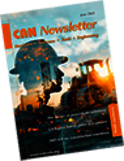
No. 9 - June 23, 2025
A word from the CiA Managing Director

The CAN data link layer protocols (CC, FD, and XL) as standardized in ISO 11898-1:2024 do not provide security measures. If needed, they must be added. According to the OSI (open systems interconnection) model, security controls can be applied to each of the seven layers, depending on the required security level and expected attack scenarios. This is standardized in ISO 7498-2:1989 (Information processing systems — Open Systems Interconnection — Basic Reference Model — Part 2: Security Architecture).
CiA has a long history in developing security measures regarding unintended misuse as well as intended manipulation of CANopen communication. This covers also unauthorized access to CANopen devices and CANopen networks. There are password options for the CANopen object dictionary access. Furthermore, there is an authentication signature option in CANopen messages specified, indicating that they are from the right origin and that in case of SDO (service data object) transmission, segments belonging together and that they have not been manipulated. Some CANopen profile specifications provide even dedicated security measures including parameter encryption.
In ISO 14229-3, there is standardized a cybersecure CAN-based interface using unified diagnostic services (UDS). This standard is used for road-vehicle diagnostics, for example. Some automakers apply this standard also for software downloads and updates.
There are also proprietary security controls for CAN-based communication on the market. This includes CAN transceivers monitoring that the assigned CAN IDs (identifier) are not used by CAN frames transmitted by other nodes. In this case, the CAN transceiver destroys those data frames by means of sending CAN error frames.
Supporting cybersecurity controls in embedded systems typically involves a trade-off between the required processing resources and security measures needed for attack vectors in a dedicated application. In order to assist the CAN community and to meet latest cybersecurity requirements for embedded systems, CiA has started to develop several cybersecurity measure building blocks.
One is a data link layer add-on protocol to be implemented in the CAN XL protocol controller hardware (also known as CANsec®, which is a European trademark by CiA). Other building blocks are higher-layer protocol (HLP) approaches suitable for CAN FD based networks. There is also a new HLP solution suitable for CANopen CC (classic), in preparation. It is also intended to specify a secure configuration method for CANopen devices.
Additionally, CiA has established the IG08 Ethernetification of CAN, which specifies the mapping of secured and compressed Ethernet frames (MACsec protected frames) to CAN frames. In the first step, a mapping to CAN FD (flexible data-rate) data frames is planned. This approach is intended for automotive applications, but not limited to them.
Furthermore, some CiA members propose the development of a higher-layer management protocol to be embedded into CAN FD data frames. This includes the indication of an optional higher-layer security measure. This means, the CAN FD data frame payload (data field and/or identifier field) contains information, whether the remaining payload is protected against attack.
At the end of 2025, CiA plans to publish a guideline for designing CAN-based secure network systems and cybersecure devices respectively ECUs (electronic control units) with CAN connectivity. CiA also observes CAN-related cybersecurity specifications and recommendations by international standardization bodies (i.e., IEC and ISO) and other nonprofit consortia (i.e., Autosar, Open Alliance, and SAE), in order to reference them, where appropriate.

ISO 11898-2 in DIS ballot
Unfortunately, the ISO 11898-2:2024 standard contains some misleading information, because some final comments had not found the way into the document. The revised ISO standard will be soon available as ISO/DIS (draft international standard) 11898-2:2025. Therefore, CiA has withdrawn the intermediate CiA 140 document, recording the missing comments and editorial improvements.
ISO/DIS 11783-2 and ISO/DIS 11783-3
The two ISO documents are in DIS ballot. They specify the Isobus physical layer respectively Isobus application, transport, and network layers. Isobus is a J1939-based network approach used in agriculture and forestry mobile machinery.
Call for comments: CiA 447 specification
CiA is initiating a revision of the CiA 447 specification series (CANopen application profile for special-purpose car add-on devices) to include recent technical feedback and align with current implementation requirements. An online meeting to resolve the final set of comments is planned for the mid of July 2025; the exact date will be communicated shortly. Please submit your comments to secretary(at)can-cia.org by July 9, 2025 and indicate whether you would like to attend the meeting.
Call for comments: CANopen for drilling machines
CiA intends to publish the CiA 455 CANopen application profile for drilling machines as a draft specification (DS). Thus, we would like to ask companies already providing CiA 455 implementation experience, if they have requests for corrections or functional extensions.
Please provide your comments to secretary(at)can-cia.org by July 30, 2025. If no comments will be received by this date, CiA will publish the current CiA 455 document as DS.
Online seminars for CAN and CANopen newcomers
On July 16 and 17 (8:00 to 12:00, UTC+2), CiA organizes two web-based seminars in English language. Introduction into physical layer, data link layer, and higher-layer protocols for CAN CC (classic) and CAN FD as well as the future of CAN are presented on July 16. The lower layers, device architecture, protocols, and profiles for CANopen CC and CANopen FD are the topics on July 17. This seminar gives also an insight into the CANopen future. Interested parties are welcome to register via email.
CiA webinar: CAN-based networking in agriculture
In a one-hour webinar on July 03 (start 8:00, UTC+2), CiA representatives give insights to CAN in vertical farming, automated feeding and milking systems as well as CAN networks in agriculture vehicles (Isobus). CiA also takes a look into the future of CAN in the agrifood industry.
The participation is free-of-charge. Registration is obligatory and is possible via email.
Embedded World 2026: Special call for papers by CiA
The Embedded World trade show takes place in Nuremberg, Germany from March 10 to 12, 2026. The Embedded World Conference in collaboration with CiA is calling for papers for a special CAN technology session. The topics are intended to provide an overview on new CAN technology trends.
Submission of paper proposals is possible until September 29, 2025. Authors will be notified by early December 2025. Interested CiA members should contact Julia Dallhammer.
CiA China Roadshow 2025
Under the name “CiA China Roadshow 2025”, CiA organizes a series of CiA technology days in Beijing, Shanghai, and Shenzhen from November 17 to 21, 2025. The event offers technical presentations about advantages and use cases of CAN XL in system and device design. The initiative is already supported by CiA members C&S, CAST, Hongke, Kvaser, NXP, Bosch, TI, Tosun, and ZLG.
Further CiA members are invited to submit a CAN XL-related presentation to CiA office by June 30, 2025. Additional organizational or sponsoring support is welcome.
CAN Newsletter magazine
The June 2025 issue focuses on mobile machines. But there are also other topics covered in this issue: Especially, the 2nd part of the CAN XL physical layer article by Magnus Hell provides a deep understanding of topology options including their trade-offs. Of course, the magazine contains also news and brief news about recently launched CAN products from chip level via interface modules to devices.
News ticker
+++ Recently, CiA has assigned CANopen vendor-IDs to NBB (DE), ESP Safety (US), and Q-Drives (AT). +++ On behalf of ISO, CiA has assigned in 2025 LIN supplier-IDs to Ampas Industries (TH), Bitron Industrie (ES), Daming Electronics (CN), Jopp Holding (DE), Mind Electronics (CN), Oechsler (DE), and Tokyo Parts Industrial (JP). +++ Call for experts: CiA received interests to develop a CANopen profile for camera control (camera motion and lens focus). +++ Parties interested in to standardize embedded CAN networks in rail-vehicle doors should contact CiA office. +++ CiA has established a liaison with ISO/TC 347 (Data-driven agrifood systems). +++ CiA collects additional comments on ISO 11992-3; the ODM11 parameter mapping naming failure (ODM input) is already listed. +++
CiA activities
- CiA education and information events
- Charged online seminars
- Charged in-house seminars
- Free-of-charge CiA webinars
- CiA technolgy days
- CiA groups
- CiA trade shows
New CiA members since the last CCN
- ESP Safety (US)
- MEIKO Maschinenbau (DE)
- Q-Drives (DE)
- Universitat de Valencia (ES)
CiA has 728 members (June 23, 2025)
New video on Youtube
- Functional safety and CANopen - CiA webinar on 2025-06-05
CiA Product Guides
Renewed entries:
- CANopen: Pixsys
Editors: Olga Fischer, Holger Zeltwanger (responsible according to the press law)
Advertising: Birgit Ruedel (responsible according to the press law)
CAN in Automation (CiA) e. V.
Kontumazgarten 3
90429 Nuremberg (Germany)
Tel. +49-911-928819-0
AG Nuremberg VR 200497
CAN Community News sign up
This 3-weekly free-of-charge email service provides CAN-related news to the entire CAN community. This includes reports about CiA activities, released CiA documents, available CiA publications, and other topics.
If you would like to subscribe to the CAN Community News please send an e-mail to mail(at)can-cia.org.
